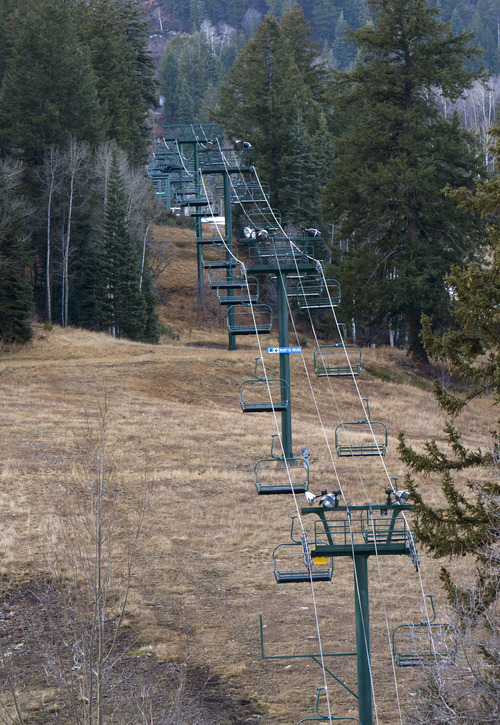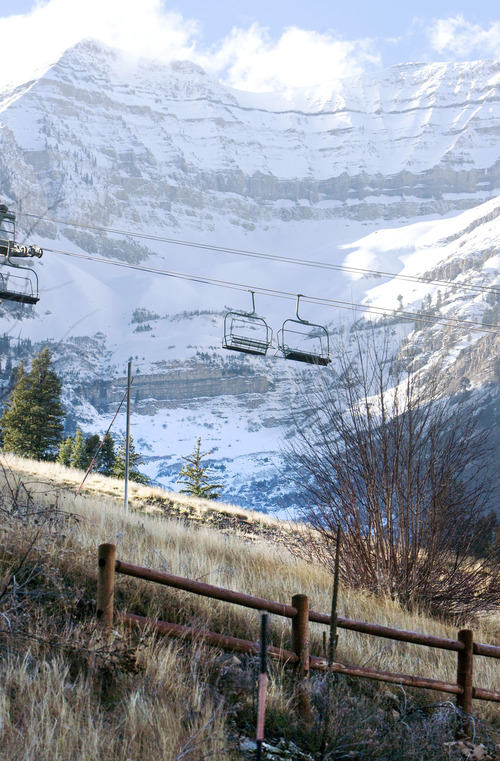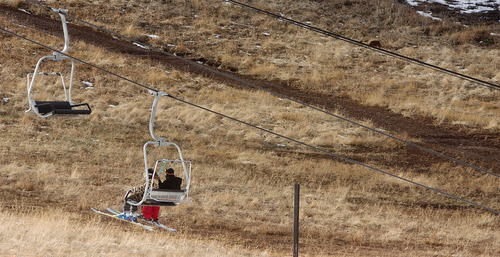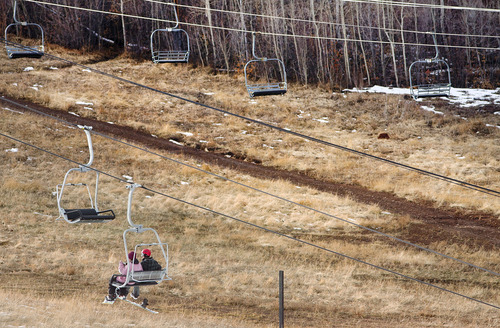This is an archived article that was published on sltrib.com in 2012, and information in the article may be outdated. It is provided only for personal research purposes and may not be reprinted.
Every lean-snow winter batters Utah and its $1 billion-a-year ski industry, according to an economic study on global warming released Thursday by the Natural Resources Defense Council.
Comparing snowfall to visitation records since 1999, the NRDC report said Utah resorts attracted 14 percent fewer skiers in the driest winter compared to the snowiest. That difference cost the state $87 million in revenue and 1,000 jobs, it said.
With global warming predicted to raise winter temperatures 4 to 10 degrees Fahrenheit this century, those bad snow years will become increasingly prevalent and the economic losses greater. Ski seasons will get shorter, snow levels will move higher and people's recreational habits will change, the NRDC report added, calculating the 38 U.S. states with ski industries will lose $1 billion in revenue and 27,000 jobs because of decreasing snow.
"For those whose livelihood depends upon a predictable winter season, such unpredictability and lack of snow can translate into a precipitous fall in revenue, an early economic indicator of what climate change looks like," said Antonia Herzog, who works on climate and clean air issues for the NRDC.
"To protect winter — and the hundreds of thousands whose livelihoods depend upon a snow-filled season — we must act now to support policies that protect our climate and slopes," she added.
Or as Auden Schendler, Aspen Ski Co.'s vice president of sustainability, put it: "The solution should be for the ski industry to get off their asses and move like it's an existential threat to the business."
"I hope this report drives radical change," he added, encouraging the industry to enlist the support of the 23 million people who skied nationally last winter "to drive critical policy change so we can ski for the next 100 years."
The Denver-based National Ski Areas Association responded with a release challenging the notion that the industry has not done enough to combat global warming.
"Ski areas have not been on the sidelines when it comes to climate change," said NSAA President Michael Berry, citing resort investments in alternative energy sources to reduce greenhouse-gas emissions and efforts to make snowmaking more efficient.
He noted that NSAA adopted a climate change policy in 2002, pushing member resorts to inventory their emissions of greenhouse gases, retrofit buildings to be more energy efficient and promote mass transit use by guests and employees.
This past year alone, Berry added, 80 to 100 resorts sent letters to Congress in support of clean-energy legislation, power plant carbon emissions standards and the wind energy production tax credit.
Ski Utah, marketing arm of the state's 14 active resorts, follows the NSAA's lead in dealing with a national issue such as global warming, said President Nathan Rafferty.
"Many of our resorts participate in programs they have going," he said, adding that "there's no argument that snow inspires visitation."
But Rafferty doubted that the decline of skier numbers in low-snow years was quite as large as the NRDC study indicated. He pointed instead to the 10 percent dropoff in skier visits between the extra snowy winter of 2010-11 (4.2 million) and unusually dry 2011-12 (3.8 million).
"You couldn't have a more dramatic difference between years," Rafferty said. "One of the challenges of our industry is when you rely on Mother Nature to be a partner, everything can change quickly."
Authored by University of New Hampshire researchers, the NRDC report attempts to answer the main question — "what's the economic impact" — that members of Congress raised last year when conservationists in the winter-sports community sought federal support to slow global warming, said Chris Steinkamp, executive director of Protect Our Winters, a nonprofit group that teamed with the NRDC on the report.
"Climate change is a job killer," Steinkamp said, contending last winter provided a "front-row seat on what climate change will look like."
Twitter: @sltrib.com —
Global warming and skiing
A report by the Natural Resources Defense Council and Protect Our Winters predicts dire consequences for the ski industry in Utah and other states if more is not done to reduce global warming:
$1 billion in losses for the winter-sports industry (snowmobiling as well as skiing), $87 million in Utah.
The loss of 27,000 U.S. jobs, including 1,000 in Utah.
Snow depths in the West could diminish 25 percent to 100 percent, depending on elevation and latitude.
In the Northeast, the length of the snow season could be cut in half.
Nordic skiers and snowmobilers will be hurt even more than alpine skiers because their playgrounds rarely have snowmaking.
Source: "Climate Impacts on the Winter Tourism Economy in the United States" —
Gear sales this fall
Sales of snow sports products from August through October fell 2 percent — to $616 million — from the same period a year earlier, said industry trade group SnowSports Industries America. An SIA release blamed the drop on a "lack of momentum from the snow-challenged 2011/2012 season," disruptions in the Northeast and South from Hurricane Sandy and concerns about impacts of the "fiscal cliff."









